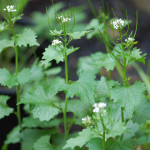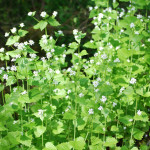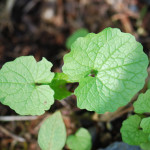Gallery:
- Garlic mustard seedling
- Garlic mustard stem and flowers
- Garlic mustard flowers
- Garlic mustard rosette
- Garlic mustard flowers
- Garlic mustard seedling
Common names:
garlic mustard, Jack-by-the-hedge
Scientific Name:
Alliaria petiolata (syns. Alliaria alliaria)
Description:
Garlic mustard is a biennial plant in the Brassicaceae (mustard) family. Garlic mustard is an aggressive woodland invader throughout much of the Continental United States. It affects both disturbed and pristine woodlands and has become one of the worst invaders of forests in the American Northeast and Midwest regions. The plant can form dense stands up to 4 ft in height and can aggressively out-compete other native plants. The most identifying set of factors for this plant are its white, cross-shaped (cruciform) flowers and presence of a garlic odor on crushed leaves.
Life cycle:
Height of mature plants
Up to 3.5 feet
Flower color:
White
Bloom time:
April through May
Look-a-likes:
Garlic mustard flowers are similar in appearance to those of other species in the Mustard family. Money plant (Lunaria annua) in particular can be confused due both species having the same stature and money plant sometimes having white flowers instead of it’s typical purple. Unlike other similar species, garlic mustard’s leaves smell of garlic when crushed.
Habitat:
Garlic mustard grows best in filtered to partial light. However, in our region garlic mustard can grow in an exceptionally wide variety of habitats including both open and shaded ones as well as upland and stream-side locations. It grows on sand, loam, and clay soils. Where this plant is most abundant in Clackamas County, it is predominantly found near rivers, roadsides, and on non-turf portions of parks and residential properties.
Impacts:
Garlic mustard can invade healthy forests and severely reduce biodiversity through highly successful competition for light. It is thought to produce a toxin that kills soil fungi that other native plants are dependent on, including native tree seedlings.
Noxious Weed Listing:
Origin:
Europe
Links:
Oregon Noxious Weed Profile
Invasive.org profile
CABI Invasive Species Compendium






